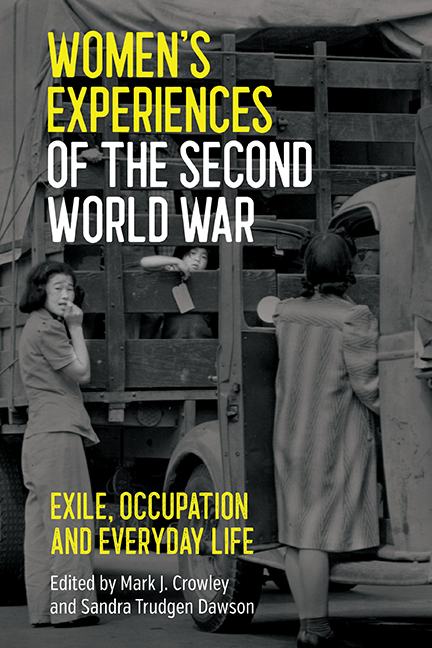Book contents
- Frontmatter
- Dedication
- Contents
- List of Illustrations
- List of Contributors
- Acknowledgements
- List of Abbreviations
- Introduction: Women’s Experiences of the Second World War: Exile, Occupation and Everyday Life
- Part One Living in Exile and under Wartime Occupation
- Part Two Living with Wartime Occupiers
- Part Three Everyday Life at Home and on the Battle Front
- Index
12 - U.S. Military Nurses and the Liberation of Concentration Camps in the Second World War
Published online by Cambridge University Press: 03 June 2021
- Frontmatter
- Dedication
- Contents
- List of Illustrations
- List of Contributors
- Acknowledgements
- List of Abbreviations
- Introduction: Women’s Experiences of the Second World War: Exile, Occupation and Everyday Life
- Part One Living in Exile and under Wartime Occupation
- Part Two Living with Wartime Occupiers
- Part Three Everyday Life at Home and on the Battle Front
- Index
Summary
‘I’ll never forget the colonel getting up and telling us that he would not hold it against any nurse if she did not want to go up there’, remembered Dorothy Maroon. He went on to say that the troops ‘could use [our] help and if we wanted to go up, if not, we could stay right where we were, until they all came back down. But every one of us, forty of us went right up there. Nobody even thought twice’. Dorothy Maroon, originally from Kingston, New York, was one of the forty nurses who made up the 131st Evacuation Hospital of the U.S. Army.
The Army Nurse Corps (ANC) was created in 1901 and the Navy Nurse Corps (NNC) in 1908. The large numbers of returning injured American soldiers transported back to the United States caused an urgent need for qualified nurses and a pressing need for military medical personnel. During the Second World War, nurses served in home front hospitals, as flight nurses, with Army Evacuation Hospitals and on military ships and trains. Nurses attached to Evacuation Hospitals made their way through Europe. Some came face-to-face with Nazi atrocities as they entered concentration camps. In 1944, Allied forces moved into spaces formerly occupied by the German military and military nurses accompanied them to assist the survivors in the Nazi camps. Upon arrival, these young women faced many things: the overwhelming presence of death and cruelty; the desperation of carefully feeding people who were starved to the brink of death; the threat of diseases such as typhus; the language barriers of treating patients from many different European countries; and the constant psychological stress of witnessing the aftermath of Nazi atrocities.
Despite the recent increase in academic interest in women's experiences during the Second World War, there is not, as yet, a thorough analysis of U.S. nurses serving with liberation forces. This chapter seeks to address this by examining the experiences of U.S. military nurses attached to units that liberated three camps: Dora-Mittlebau, a sub-camp of Buchenwald located in Thuringia, Germany; Dachau, in southern Germany; and Gusen, a sub-camp of Mauthausen in Linz, Austria. As some of the first Americans to come across the horrors of the concentration camps, these nurses serve as historical witnesses to Nazi atrocities. Notably, the experiences of these women include both physical and emotional challenges which often persisted long after the conclusion of the war.
- Type
- Chapter
- Information
- Women's Experiences of the Second World WarExile, Occupation and Everyday Life, pp. 209 - 222Publisher: Boydell & BrewerPrint publication year: 2021

